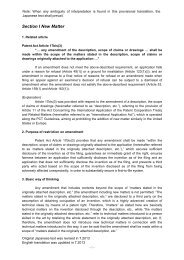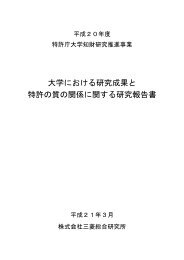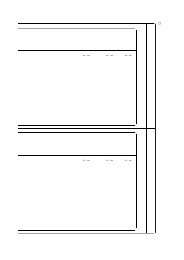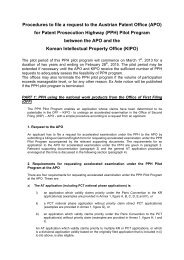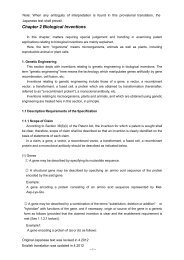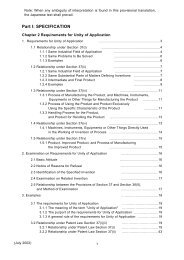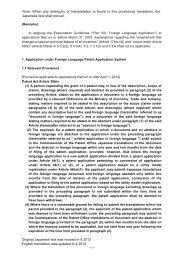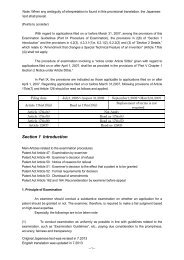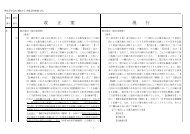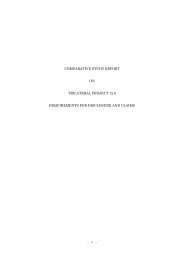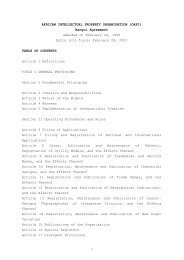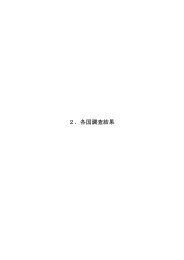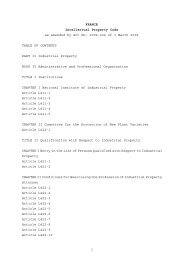Chapter 2 Novelty and Inventive Step - Japan Patent Office
Chapter 2 Novelty and Inventive Step - Japan Patent Office
Chapter 2 Novelty and Inventive Step - Japan Patent Office
You also want an ePaper? Increase the reach of your titles
YUMPU automatically turns print PDFs into web optimized ePapers that Google loves.
Part II <strong>Chapter</strong> 2 <strong>Novelty</strong> <strong>and</strong> <strong>Inventive</strong> <strong>Step</strong><br />
[Example 3] The presence of the claimed automatic wrapping machine is not considered to<br />
be obstructive due to the application of the technical idea described in the cited inventions 2 <strong>and</strong><br />
3 to the cited invention 1, the technical idea in which a single robot with two gripping means<br />
having independent working functions <strong>and</strong> the robot enables them to conduct two kinds of works<br />
selectively.<br />
(Reference: Decision by the Tokyo High Court, February 10, 1999 [Heisei 10 (Gyo Ke) 131]; an<br />
example of denying the presence of an obstructive factor)<br />
[Example 4] There is no fault in the judgment of appeal ruling that "Commonly, inert solvents<br />
for this type of general coating composition are appropriately contained in the compositions to<br />
adjust the property, such as viscosity, according to the coating means or conditions…, <strong>and</strong> the<br />
cited invention does not provide any technical obstruction relating to application of the inert<br />
solvents. Accordingly, it is understood that applying inert solvents (with diluents) to the cited<br />
invention is an idea which a person skilled in the art could easily conceive."<br />
(Reference: Decision by the Tokyo High Court, May 19, 1999 [Heisei 9 (Gyo Ke) 111]; an<br />
example of denying the presence of an obstructive factor)<br />
(2) Well-known or commonly used arts as references of the claimed inventions should be<br />
submitted since they are important materials constituting the state of the art, which can be<br />
grounds for a notice of reasons for refusal to a maximum extent, unless they are so well-known<br />
that the submission seems unnecessary. They are considered important regardless of whether or<br />
not they are used as a basis to find the cited inventions or to confirm the knowledge of a person<br />
skilled in the art (about the state of the art including the common general knowledge) or to<br />
confirm ability (about using general technical means for research <strong>and</strong> development or about<br />
creating arts ordinarily).<br />
(3) The Prior arts before the filing of the applications described in the specifications of the<br />
claimed inventions could be a basis of determining the inventive step of the claimed inventions.<br />
This can be accomplished by citing the prior arts as components of the state of the arts as of the<br />
filing when the applications admit that the prior arts are publicly known.<br />
(4) The inventive step of the claimed inventions providing formal <strong>and</strong> substantial alternatives<br />
Note relating to the matters used to specify the inventions for which patents are sought are denied<br />
when the examiners compare the claimed invention, whose only one of these alternatives is<br />
presumed to be a factor used to define the claimed inventions, <strong>and</strong> the cited inventions for<br />
reasoning <strong>and</strong> they uphold the reasoning if the reasoning is valid.<br />
In addition, this approach does not influence the approach for deciding the appropriate time to<br />
finish prior art searches. For details, see "Part IX How to Proceed Examinations."<br />
Note:<br />
For details of "Formal or Substantial Alternatives," see Note 1 of 1.5.5 above.<br />
(5) The inventions filed for processes for manufacturing products <strong>and</strong> use of the products<br />
involve inventive step when the products per se involve inventive step in principle.<br />
(6) Commercial successes or facts following the successes are analyzed to positively<br />
support the presence of the inventive step insofar as the examiners are convinced by applicantsubmitted<br />
assertions or proof that these facts are derived from the features of the claimed<br />
inventions, not from other factors such as sales promotion techniques or advertisements.<br />
27



